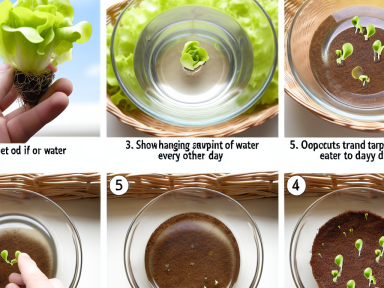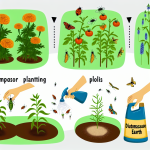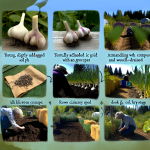Why Regrow Lettuce from the Base?
Regrowing lettuce from the base is an excellent way to maximize yield, minimize waste, and ensure a continuous supply of fresh greens. By reusing the lettuce base, you not only save money but also make an eco-friendly choice.
Materials Needed
- Romaine or other leaf lettuce base
- Shallow dish or container
- Water
- Optional: Potting soil and a pot
Steps to Regrow Lettuce
- Prepare the Base: Cut the lettuce leaves around one inch above the base. This bottom part, which is often discarded, will be your starter.
- Place in Water: Put the lettuce base in a shallow dish with about half an inch of water. Ensure the cut side is facing up.
- Provide Light: Place the dish on a sunny windowsill. Lettuce requires a lot of light, so select a location that gets at least 6 hours of sunlight each day. If natural light is minimal, consider using a grow light.
- Change Water Regularly: Change the water every 1-2 days to prevent mold and provide fresh nutrients.
- Sprouting: In about 3-4 days, you will notice new leaves starting to sprout from the center of the base. This is a sign that the rooting process is successful.
- Develop Roots: Continue this process for 10-14 days. During this period, the roots should develop adequately. The sprouts will be more pronounced, and the base will become slightly more robust.
- Optional: Transplanting to Soil: If you prefer, you can transfer the growing base into soil. Fill a pot with well-draining potting soil, create a small hole, and plant the base, ensuring the new growth is above the soil level. Water thoroughly.
Care and Harvest
- Watering: Keep the soil consistently moist but not waterlogged. Lettuce has shallow roots, so it doesn’t require deep watering.
- Feeding: If you notice slow growth, consider a diluted liquid fertilizer weekly, especially if you’re growing it indoors.
- Pest Control: Keep an eye out for common pests like aphids or slugs. Use organic pest control methods such as neem oil or diatomaceous earth if needed.
- Harvest: Within 3-4 weeks, your regrown lettuce should be ready for its first harvest. Cut the outer leaves first, allowing the inner leaves to continue growing. This method promotes extended growth and multiple harvests from a single plant.
Final Tips
- Multiple Regrows: While you can regrow lettuce multiple times from the same base, subsequent regrowths might be less vigorous. Consider starting a new batch every few weeks for a continuous supply.
- Variety Selection: Although romaine is popular, experiment with butterhead, loose-leaf, or even iceberg lettuce to find what works best in your setup.
- Environmental Control: Lettuce thrives in cooler conditions (60-70°F or 15-21°C). If growing indoors, ensure adequate airflow and avoid excessively warm spots.
With these detailed steps and tips, regrowing lettuce from the base can be a delightful and rewarding experience that brings fresh greens to your table while teaching the essence of sustainable gardening practices.



GIPHY App Key not set. Please check settings